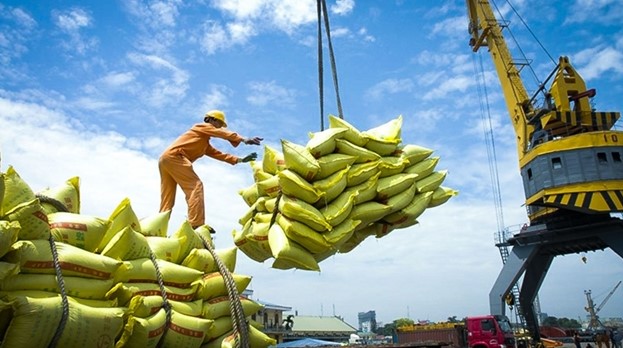
ANN/VIETNAM NEWS – Vietnam’s rice industry is experiencing a significant drop in export prices, even as the volume of shipments increases, highlighting the volatility of the global grain market.
Borneo Bulletin – June 17, 2025
According to the Ministry of Agriculture and Rural Development, the country exported an estimated 4.5 million tonnes (4.5 billion kilogrammes) of rice in the first five months of 2025, generating approximately USD2.34 billion.
While the quantity rose by 12.2 per cent year-on-year, export value declined by 8.9 per cent. This sharp contrast resulted from a significant decrease in the average export price, which dropped to around USD0.516 per kilogramme (kg), down 18.7 per cent compared to the same period last year.
Domestically, paddy prices across the Mekong Delta remained relatively stable throughout the past week.
In provinces like Vinh Long and Tien Giang, IR 50404 paddy continued to be traded at VND6,600 per kg (USD0.26).
OM18 was priced at VND7,500 per kg (USD0.295) in Can Tho, VND8,100 per kg (USD0.319) in Soc Trang, and VND7,000 per kg (USD0.275) in Tien Giang.
Jasmine rice reached VND8,400 per kg (USD0.331) in Can Tho and VND7,100 per kg (USD0.28) in Tien Giang.
ST 25 remained one of the most valuable varieties, holding at VND9,500 per kg (USD0.375).
In An Giang Province, fresh IR 50404 paddy was being purchased by traders at VND5,400-5,600 per kg (USD0.213-0.221), OM 380 at VND5,200-5,400 per kg (USD0.205-0.213), and OM 5451 at VND6,200-6,400 per kg (USD0.245-0.253), according to the provincial Department of Agriculture and Environment.
Retail rice prices in An Giang also displayed diversity, depending on type and quality.
Ordinary rice varieties ranged between VND14,000-15,000 per kg (USD0.553-0.593), while aromatic long-grain rice imported from Thailand reached VND20,000-22,000 per kg (USD0.79-0.87).
Jasmine rice was sold at VND16,000-18,000 per kg (USD0.63-0.71), Nang Hoa at VND21,000 per kg (USD0.83), and Japanese rice, along with Huong Lai, was priced at VND22,000 per kg (USD0.87).
Varieties like Soc Thai and fragrant rice from Taiwan also stood at around VND20,000 (USD0.79) per kg.
In processing facilities, the price of raw IR 504 rice was between VND7,900-8,000 per kg (USD0.312-0.316), with the finished product reaching VND9,500-9,700 per kg (USD0.375-0.383).
OM 380 raw rice was sold at VND7,850-8,000 per kg (USD0.31-0.316), while processed OM 380 rice fetched VND8,800-9,000 per kg (USD0.347-0.355).
By the end of May, Vietnamese farmers had planted roughly 4.22 million hectares of rice.
However, the harvested area shrank to 2.57 million hectares, producing an estimated 17.5 million tonnes of rice, down two per cent year-on-year.
The yield per hectare saw a slight improvement to about 6.8 tonnes.
The Philippines remained Vietnam’s largest rice importer, accounting for 41.4 per cent of the country’s total exports.
Cote d’Ivoire followed with 11.9 per cent, and China with 10.3 per cent.
Despite the volume, the Philippines’ import value dropped 21.8 per cent in the first four months.
In contrast, exports to Côte d’Ivoire surged by 2.7 times, and shipments to China increased by 83.7 per cent.
Bangladesh posted the most dramatic rise – a 515.6-fold increase in value – while Indonesia recorded a sharp 97.9 per cent decline.
The Vietnam Food Association (VFA) reported that Vietnam’s five per cent broken rice is currently quoted at USD0.393 per kg, down USD0.003 from last week.
A trader in Ho Chi Minh City noted the Philippines is seeking to diversify its supply, posing a potential risk to Vietnam’s traditional export structure. However, Vietnam is increasingly targeting high-quality markets like Japan and Europe, where premium rice can command better prices per kg.
India, the world’s largest rice exporter, also saw declines.
Its five per cent broken parboiled rice is now priced at USD0.380-0.386 per kg, and regular white rice of the same grade at USD0.373-0.378 per kg.
The drop has been attributed to a weaker rupee and expectations of another bumper crop, supported by favourable monsoon forecasts.
The Indian government recently increased its minimum support price by only three per cent, the smallest margin in five years, to manage domestic stockpiles.
Thailand’s five per cent broken rice remains steady at USD0.410 per kg. A Bangkok-based trader said overall demand is still quiet, with markets like the Philippines and Indonesia showing limited interest.
